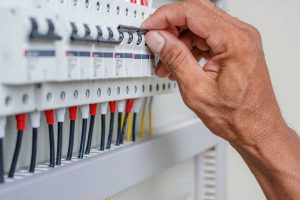30 seconds summary
Circuit breakers play a crucial role in protecting your vending equipment by automatically cutting off electrical flow during overloads or short circuits.
This prevents damage to internal components, reduces fire risk, and extends the machine’s lifespan.
By instantly reacting to electrical faults, circuit breakers safeguard both the equipment and users, ensuring safe and reliable operation.
Vending machines are an integral part of modern commerce, providing convenient access to snacks, drinks, and a growing array of products. These machines are found in office buildings, schools, hospitals, airports, and many other public places. Behind their seemingly simple operation lies a complex network of electrical systems designed to ensure smooth, uninterrupted performance. One of the most essential yet often overlooked components in these systems is the circuit breaker.
Circuit breakers are crucial in safeguarding vending equipment from electrical faults, power surges, and overloads. Without proper circuit protection, vending machines are susceptible to damage, costly downtime, and even fire hazards. This article explores in-depth the role of circuit breakers in vending machines, highlighting their importance, functionality, and how they integrate with other circuit protection accessories to ensure reliable operation.
1. Understanding the Electrical Anatomy of a Vending Machine
To understand why circuit breakers are so important, it’s essential to first understand how a vending machine operates electrically. A typical vending machine includes:
Power supply system: Converts and distributes power to various internal components.
Controller board: Acts as the brain of the machine, managing product dispensing, payment processing, and system diagnostics.
Motors and actuators: Control the mechanical parts responsible for product delivery.
Refrigeration units (for cold vending machines): Maintain product freshness.
Lighting and display systems: Provide user interface and machine status indicators.
Each of these components draws electrical current. In the event of a fault, such as a short circuit, power surge, or component failure, the current can spike to dangerous levels. This is where circuit breakers come into play.
2. What is a Circuit Breaker?
A circuit breaker is an automatically operated electrical switch designed to protect an electrical circuit from damage caused by excess current, typically resulting from an overload or short circuit. Its basic function is to detect faults and interrupt current flow.
Unlike fuses, which must be replaced once blown, circuit breakers can be reset after they trip. This makes them not only cost-effective but also more user-friendly, especially in vending applications where maintenance access might be limited.
Key Functions:
Overload protection: Prevents wires and components from overheating due to prolonged excessive current.
Short-circuit protection: Immediately interrupts current in the event of a fault, preventing damage and potential fire.
Manual switching: Can be used to manually disconnect power for maintenance.
3. Why Circuit Breakers Matter in Vending Equipment
A. Preventing Equipment Damage
Vending machines consist of sensitive electronics and precision mechanical components. Overcurrents can cause irreversible damage to circuit boards, compressors, motors, and other critical systems. A properly rated circuit breaker ensures that any abnormal current is cut off before it reaches the internal systems.
B. Reducing Downtime
Every moment a vending machine is out of service is a loss in potential revenue. Faults that cause a machine to shut down often lead to service calls, which can be time-consuming and costly. A circuit breaker that trips appropriately protects the system and allows for quick troubleshooting and reset, minimizing downtime.
C. Enhancing Fire Safety
Electrical faults are a common cause of fires in electronic systems. In vending machines, which are often located in unattended areas, the risk is magnified. Circuit breakers mitigate this risk by cutting off current before overheating or sparking can occur.
D. Simplifying Maintenance
With circuit breakers in place, technicians can more easily diagnose and isolate problems. Many vending machine circuit breakers include visual indicators or status LEDs that inform users when a fault has occurred.
4. Types of Circuit Breakers Used in Vending Equipment
There are several types of circuit breakers, each suited to specific applications within a vending machine:
A. Thermal Circuit Breakers
These use a bimetallic strip that bends and trips the breaker when heated by excessive current. They’re often used for the general protection of low-voltage circuits in vending machines.
B. Magnetic Circuit Breakers
These respond to the magnetic field created by high current flow. They react faster than thermal breakers and are ideal for protecting sensitive electronics and motors from short circuits.
C. Thermal-Magnetic Circuit Breakers
Combining both thermal and magnetic mechanisms, these are the most common in vending equipment. They provide robust protection against both overloads and short circuits.
D. Ground Fault Circuit Interrupters (GFCIs)
Used when vending machines are installed outdoors or in wet environments. GFCIs detect differences between incoming and outgoing current, protecting against shock hazards.
5. Selecting the Right Circuit Breaker for Your Vending Machine
The selection of a circuit breaker depends on several factors:
Voltage and current rating: Must match the specifications of the machine’s power system.
Trip characteristics: Determine how fast the breaker responds to overcurrent.
Environmental conditions: Humidity, temperature, and exposure to water all influence the breaker type.
Mounting and size: Must be compatible with the machine’s design and available space.
It is advisable to work with a technician or consult the manufacturer’s specifications when choosing or replacing circuit breakers in vending machines.
6. Integrating Circuit Protection Accessories
In addition to circuit breakers, many vending machines are equipped with circuit protection accessories that work together to provide layered security. These accessories include:
A. Surge Protectors
Protect against voltage spikes caused by lightning, power outages, or fluctuations in the electrical grid. These are especially important for machines connected to outdoor or unreliable power sources.
B. Fuses
Though less commonly used now due to the advantages of breakers, fuses still find a role in certain low-voltage applications. They provide a cheap, single-use layer of protection.
C. Power Distribution Blocks
Allow power to be safely distributed across multiple circuits in larger vending machines. These work in tandem with breakers to isolate and protect various subsystems.
D. Remote Monitoring Systems
Some modern vending machines feature integrated sensors and IoT-based monitoring, which can alert operators to electrical issues or tripped breakers in real time.
When used together, circuit breakers and these accessories create a resilient and fault-tolerant electrical system for vending equipment.
7. Common Electrical Faults in Vending Machines
Understanding the types of faults that can occur helps highlight the importance of circuit breakers:
A. Power Surges
Sudden spikes in voltage can damage sensitive electronics. Breakers can trip to prevent this damage.
B. Short Circuits
Caused by faulty wiring or failed components, short circuits can lead to instantaneous damage without protection in place.
C. Overloading
Sometimes, more current is drawn than the system is designed to handle—especially if upgrades or add-ons are installed. Breakers stop this before wires or components are damaged.
D. Ground Faults
Often seen in machines installed outdoors, ground faults occur when current strays from its intended path, posing safety risks.
8. Installation and Maintenance Best Practices
Even the best circuit breakers can’t do their job if not properly installed or maintained. Here are some best practices:
A. Proper Sizing
Ensure the breaker is appropriately rated for the equipment it protects. Over-sized breakers may not trip in time; under-sized ones may trip unnecessarily.
B. Regular Inspections
Inspect breakers for wear, corrosion, or damage. Environmental exposure, vibration, and age can reduce their effectiveness.
C. Periodic Testing
Test breakers periodically by manually tripping and resetting them to ensure functionality. Some advanced breakers include self-test features.
D. Clean Electrical Panels
Keep breaker panels and enclosures clean and free of dust or moisture. Contaminants can cause overheating or faulty operation.
9. Innovations in Circuit Breaker Technology for Vending Machines
The world of circuit protection is evolving rapidly, and new technologies are making their way into vending equipment:
A. Smart Circuit Breakers
These digitally connected breakers allow for remote monitoring, control, and diagnostics. Operators can receive instant alerts when a breaker trips or when load levels approach unsafe limits.
B. Miniature Circuit Breakers (MCBs)
Compact and highly efficient, MCBs are ideal for modern vending machines where space is limited and multiple protection zones are needed.
C. Resettable Polymeric Devices
Also known as PTC (positive temperature coefficient) devices, these act like fuses but automatically reset after cooling down. They’re increasingly used for secondary protection.
Conclusion
Circuit breakers are the unsung heroes of vending machine reliability and safety. They protect sensitive components from damage, ensure user safety, and prevent costly downtime. Along with circuit protection accessories, these devices form a comprehensive shield against the unpredictable nature of electrical systems.
As vending machines become more advanced and interconnected, the need for robust and intelligent circuit protection will only grow. Investing in the right circuit breakers, maintaining them properly, and understanding their function is crucial for anyone involved in vending machine operation, design, or maintenance.
Whether you manage a small network of snack machines or a fleet of sophisticated smart vending kiosks, never underestimate the importance of circuit breakers. They may be small and hidden, but their impact on the longevity and safety of your equipment is massive.






